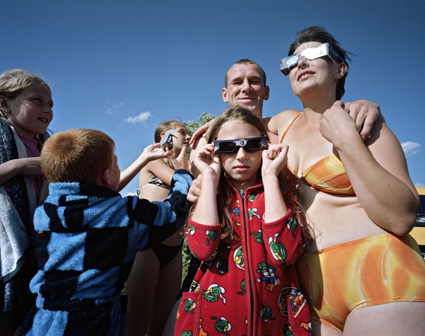 Group of Russians admiring the eclipse in the beach of Pervomaiskoje, Altai Krai, the locality where Tommi Taipale arrived on the eclipse day on his Journey to the Eclipse. Photo credit: Tommi Taipale
Group of Russians admiring the eclipse in the beach of Pervomaiskoje, Altai Krai, the locality where Tommi Taipale arrived on the eclipse day on his Journey to the Eclipse. Photo credit: Tommi Taipale
Last Summer, curatorial research group Capsula embarked on the first of its Curated Expeditions, demonstrating in the process that you don’t need an intergalactic spaceship to uncover new territories and make meaningful discoveries. This series of Curated Expeditions are research trips that engage with earthly phenomena through artistic investigation.
The 1st Expedition of Capsula invited 3 artists to observe a total solar eclipse which took place on August 1st over a vast area stretching from Canada, through to Russia, Mongolia and China. The observation location selected is the scientific Zoo in Novosibirsk, the capital of Siberia. Eclipse started in Novosibirsk at 17.45 pm.
The artists, German Agnes Meyer-Brandis, Catalan Mireia C. Saladrigues collaborated with the Zoo personnel and other experts to study the celestial phenomena and its impact on the animals and the visitors of the Zoo while Finnish photographer Tommi Taipale focused his work on the cultural and geographical distance between of Finland and Siberia.
Because Capsula’s latest focus is the relation between art and biology and environmental culture, the expeditions go hand in hand with a more leisurely and sometimes old-fashioned Philosophy of Voyage: walking, bob-sleighing, swimming, hitchhiking, rowing, sailing, trains and submarines. The travel from Finland to Novosibirsk took several days: While Tommi chose to hitch-hike, curator Ulla Taipale, Agnes Meyer-Brandis and Mireia C. Saladrigues spent three days to get there by train, taking the romantic-sounding Trans-Siberian Line.
With a background in Environmental Engineering and and Communications, Ulla Taipale is one of the founders and the current head of Capsula. I asked her to give us more details about this first curated expedition to Siberia:
Can you present us Capsula briefly? When and how it was born? What are its objectives?
 Capsula was founded by Mónica Bello Bugallo and Ulla Taipale in 2005 in Barcelona. It is a platform that creates cultural content and curatorial projects dealing with art, science and nature. The first project of Capsula was Days of Bioart in 2006. The event was a combination of a bioart seminar and SymbioticA Tissue Engineering and Art – workshop and organized in Centro de Arte Santa Mónica and in a laboratory of faculty of biology of Universidad de Barcelona. The cross-disciplinary approach has been characteristic of Capsula`s work from the beginning. In recent years Capsula has collaborated with cultural institutions such as CCCB (Centre for Contemporary Culture of Barcelona) and Intermediae in El Matadero of Madrid, DRU-Digital Reserch Unit of Huddersfield, among others, and have brought to these events many of the leading creators and researchers in the field of art, science and/or technology, such as Critical Art Ensemble, Tissue Culture & Art Project, Andy Gracie, Natalie Jeremijenko, Vandana Shiva, Jens Hauser, Ramon Guardans and Eugene Thacker, to name a few. The objective is to create interdisciplinary projects related with art&science, with a special attention on the natural and artificial environments.
Capsula was founded by Mónica Bello Bugallo and Ulla Taipale in 2005 in Barcelona. It is a platform that creates cultural content and curatorial projects dealing with art, science and nature. The first project of Capsula was Days of Bioart in 2006. The event was a combination of a bioart seminar and SymbioticA Tissue Engineering and Art – workshop and organized in Centro de Arte Santa Mónica and in a laboratory of faculty of biology of Universidad de Barcelona. The cross-disciplinary approach has been characteristic of Capsula`s work from the beginning. In recent years Capsula has collaborated with cultural institutions such as CCCB (Centre for Contemporary Culture of Barcelona) and Intermediae in El Matadero of Madrid, DRU-Digital Reserch Unit of Huddersfield, among others, and have brought to these events many of the leading creators and researchers in the field of art, science and/or technology, such as Critical Art Ensemble, Tissue Culture & Art Project, Andy Gracie, Natalie Jeremijenko, Vandana Shiva, Jens Hauser, Ramon Guardans and Eugene Thacker, to name a few. The objective is to create interdisciplinary projects related with art&science, with a special attention on the natural and artificial environments.
The last project of Capsula, called Curated Expeditions, was launched almost one year ago. The project is dedicated to observing and experiencing fascinating natural phenomena through the work of artists, scientists and other cultural agents. It also wants to revive leisurely traveling experiences, which have almost been cast aside by the frantic pace of modern day life. The first expedition was carried out last summer in Russia to explore and study the total solar eclipse and animal behaviour during this celestial phenomenon. This was realized through the proposals of German media artist Agnes Meyer-Brandis and Catalonian visual artist Mireia C. Saladrigues. On the other hand the expedition of Finnish photographer Tommi Taipale focused on the cultural and geographical distance between of Finland and Siberia during his journey to the eclipse by hitch-hiking. The project was done in collaboration with Novosibirsk Zoo in Siberia and with several other institutions, mentioned in the end of the interview.
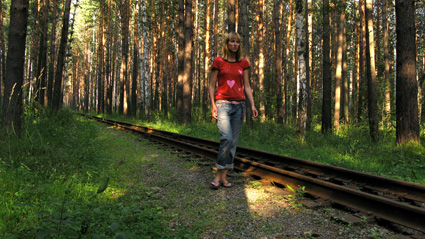 Ulla Taipale wandering in the vast forest by the Novosibirsk Zoo. Photo credit: Ulla Taipale
Ulla Taipale wandering in the vast forest by the Novosibirsk Zoo. Photo credit: Ulla Taipale
Curated Expeditions is a long-term project. Can you explain what are its long-term goals?
The object is to make a series of expeditions dealing with earthly phenomena in remote and nearby destinations . The aim is to stimulate production and exhibition of multidisciplinary artistic creation related with nature’s spectacles. I have many ideas for new expeditions and for the targets of the artistic survey, but these plans are in an early stage and not ready to be published yet.
Through these projects I want to give the protagonism to the natural phenomenon and promote positive emotions that can be experienced in natural and artificial environments. The question is: Could the natural phenomenon and the spectacles of the nature still fascinate a major quantity of people in the modern world, saturated by entertainment like video games and action movies? And, could these splendid and thrilling emotions lived within the nature, shift the attitude of people to more respectful and caring direction concerning their environment? Generally speaking, conservationism and environmentalism seem to be related with obligations and rejections that limit the level of life causing bad conscience. Sustainable way of life is related with low quality life – without luxury. I expect that the outcome of the expeditions – singular artworks, exhibitions, public debates and writings address towards to the enriching experiences reducing a distant and unconcerned attitude when thinking about nature and our relationship with it.
So, to name some of the more tangible goals – maybe in five years and after several expeditions a publication will be made out of these projects. And the new artworks created are to be exhibited in traditional and non-conventional spaces. I would also like to gather interesting people, not necessarily experts, but persons with good ideas to discuss publicly the issues indicated by the expeditions. The idea is to break categorizations and frontiers between different disciplines.
Curated Expeditions explored a phenomenon which lasted 2 minutes and 20 seconds. Yet you deliberately traveled using relatively slow and old-fashioned ways. You, Agnes, and Mireia took an almost 3 day train ride from Helsinki to Novosibirsk, while it took Tommi a whole week to get there by hitch-hiking. Why was it so important to undertake a long journey when (apparently) you didn’t have to?
Curated Expeditions wants to revive leisurely traveling experiences that personify the Capsula Philosophy of Voyage. Walking, bob-sleighing, swimming, hitchhiking, rowing, sailing, trains and submarines, just to name a few, are means of transport that permit your soul to arrive to the destiny simultaneously with your body. No matter if the destiny for the artistic exploration of the natural phenomenon is near or far, the participants should be aware of the distance and the differences- cultural and geographical ones – between of the departure and arrival.
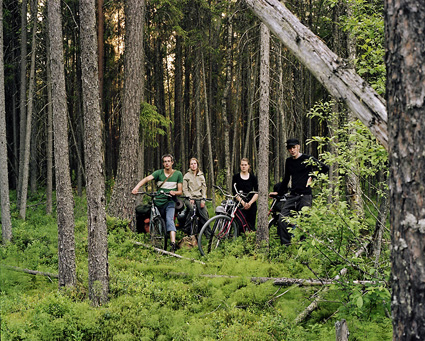 Tommi Taipale, Siiri Anttila, Selja Eskonen and Heikki Tuorila cycling in Russia. Photo credit: Tommi Taipale
Tommi Taipale, Siiri Anttila, Selja Eskonen and Heikki Tuorila cycling in Russia. Photo credit: Tommi Taipale
We didn´t have to spend three days on the way and also it would have been less expensive and troublesome to take a direct flight to Novosibirsk. Many people warned us telling about uncomfortable and dangerous trains, we were asked several times why not to travel flying, that Russian people were noisy, in the summer the wagons would be hot and in general very inconvenient for three women with a lot of luggage. I have to admit, that I was questioning the decision many times. Also buying the tickets for exact days and routes was not easy at all because of Russian bureaucracy, holiday season and the mass movement of eclipse tourists. But, at the end we were in Helsinki railway-station with our huge luggage – Agnes was carrying 60 kilos on her – and the journey could start.
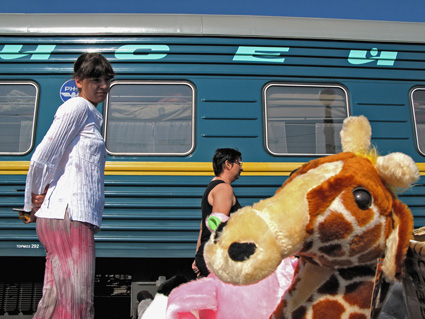 A break in a station on the Russian Trans-Siberian railway. Photo credit: Ulla Taipale
A break in a station on the Russian Trans-Siberian railway. Photo credit: Ulla Taipale
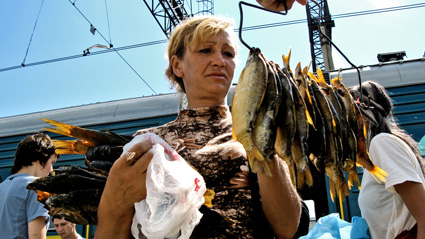 Russian train passanger selects fish, offered by “babuskas”, local grandmothers sell in railway-stations. Photo credit: Ulla Taipale
Russian train passanger selects fish, offered by “babuskas”, local grandmothers sell in railway-stations. Photo credit: Ulla Taipale
Once in the train, we did forget our doubts! During the three days between Helsinki and Novosibirsk we were able to learn some Russian, to know Russians, to know each other on a more personal level, converse, read books, watch the changing scenery from the window and while enabled and disconnected from the internet, got slowly into the mood of Capsula Expedition. And once we arrived, we were sad to leave our temporal itinerant home, the Russian co-travelers, the samovar and the rhythmic sound of the train.
Coming to Tommi, he spent two weeks on the road to get to Novosibirsk. As an experienced Russian traveler and wanderer, he could estimate roughly how long time it would take to get from place to another. During the first days he traveled with three friends using recycled bicycles and then alone towards to the tundra by hitch-hiking and using some river-boats. This extra round to the northern part of Russia was his attempt to escape the heat – the summer in Russia was hot, during July – August the daily temperatures rose up to 30ºC almost every day. However, even in Salehard it was sweaty!
Hitchhiking in Russia is a very common way to travel. To get a hitch is not difficult and a lonely Finn on the road wakens curiosity and hospitality in Russians – often he was offered also a place to sleep on the way.
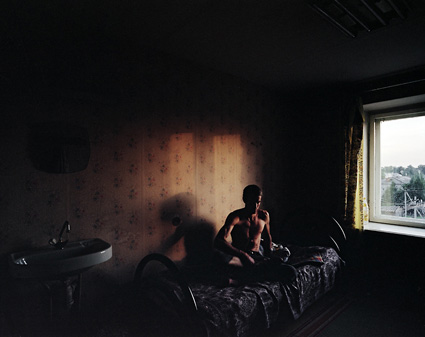 Tommi Taipale in a hotel room in Nikolsk, on his way to the total eclipse. Photo credit: Tommi Taipale
Tommi Taipale in a hotel room in Nikolsk, on his way to the total eclipse. Photo credit: Tommi Taipale
Tommi´s photographs reflect his meetings with ordinary people that can be found traveling alone leisurely in a strange territory. He has a basic Russian knowledge that allows him to connect with people who coincide with his fortuitous way that doesn’t respect timetables. His pictures open doors to the everyday life of Russians showing what often remains behind of the topics of the country, such as the life habits of the of class of new rich, the alcoholism and poverty, and the country’s military and energy power. In these glimpses shown in Tommi´s pictures a grandmother offers a lonely traveler sweet tomatoes or cranberries, a mine worker invites him to take a bath in a banja, Russian sauna or a group of silent men waiting for a river-boat in the dawn.
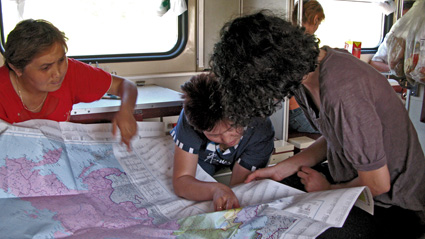 Mireia C. Saladrigues studies Russian map with Kirgisian co-travellers in the Trans-Siberian wagon. Photo credit: Ulla Taipale
Mireia C. Saladrigues studies Russian map with Kirgisian co-travellers in the Trans-Siberian wagon. Photo credit: Ulla Taipale
By the way, is a journey on the Trans-Siberia as romantic as it sounds?
To our surprise it was big pleasure, nicer than we could ever imagine. You can do it more comfortably with a bigger budget in a higher class, having a daily shower and your own toilet, but then you might miss the contact with the co-travelers and a part of the taste of adventure. And the official Russian time, that shows Moscow hour where ever the train is in Russia, makes your daily rhythm disappear – instead of looking at your watch to start eating and sleeping, you let your state of mind or energy levels decide what to do. Our public relations and Russian language rehearsals always got more interesting and intensive the nearer we got to Novosibirsk. During the last hours in the train, Mireia found the first volunteer, a Russian girl to work with her in the project in Novosibirsk. Something very characteristic for Mireia´s work, which is based on her interpersonal skills and communication with people.
Anyway, I have to admit that we three adapt well to tough conditions. Traveling in Russian trains is good as long as you don’t except too comfortable a life and are not too prejudiced.
The zoo of Novosibirsk in Siberia seems to be a very intriguing place. How did you get to know about its existence? How did the owners and workers of the zoo welcome a bunch of artists keen on mingling with their animals?
When the decision to start the Curated Expeditions project by investigating a solar eclipse was taken, I started a closer study of the zone of totality, that was a vast area from Alaska, Siberia and Mongolia to China.
In 1999 I experienced my first solar eclipse in Hungary, in a small village of Rapabatona by the Danube, where I cycled from Vienna. I was astonished by the reaction of animals, mostly birds and insects, during the eclipse. So, when I found out that the biggest and oldest Zoological Park of Russia was situated in Novosibirsk, just in the middle of the eclipse zone, I decided to focus the project on the animal behaviour during the eclipse. The negotiations with the Zoo started and after weeks of correspondence and phone calls they agreed to collaborate.
We were made very welcomed. Sveta, the secretary of the Zoo, came to pick us up from the railway-station, and took us to our new home. We were invited to stay in an apartment situated in the Zoo area that is normally used by foreign zoologists and researchers visiting the Zoo. Novosibirsk Zoo Park is huge. The area consists of 53 hectares of pine forest and it is a home for around 12 000 animals and 634 species. Bengal tigers and snow leopards are among the 120 endangered species represented in the Zoo that can be found in the Red Book. Our neighbours and their numerous different ways of sonic communication filled the air with roaring, yelling and howling, especially in the dusk and dawn. Our communication with zoo workers was possible thanks to Sveta and Maria, Siberian English literature students, who were the links between us, the zoo workers and the journalists. English is rarely spoken in Russia, but the young people start to be stronger in languages than their parents who did their studies during the Soviet time.
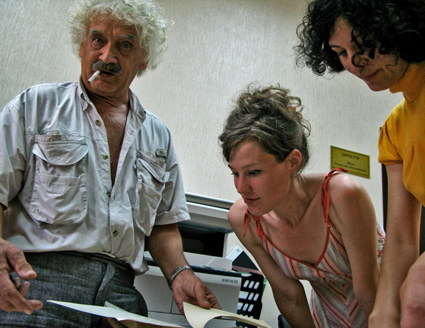 Agnes Meyer-Brandis and Mireia C. Saladrigues study notes from the year 1981´s annular eclipse animal behavior with the Zoo director Rostislaw Shilo.Photo credit: Ulla Taipale
Agnes Meyer-Brandis and Mireia C. Saladrigues study notes from the year 1981´s annular eclipse animal behavior with the Zoo director Rostislaw Shilo.Photo credit: Ulla Taipale
We presented our intentions to the director Rostislaw Shilo, who runs the Zoo with 40 years of experience. Him and his wife, the scientific director Olga Shilo, are highly liked and respected personalities in Novosibirsk and people from taxi-drivers to biologists have positive things to say about them. In parallel with running the biggest Zoo in Russia and his scientific work, Rostislaw Shilo is also a Siberian eco politician, influencing environmental issues from the parliament of Siberia. Once we explained the goals of the expedition he didn’t hesitate in supporting the project. Not only did he offer us nice accommodation for nine days, but also helped us further in achieving rare moon geese for Agnes´ experiment and in gaining visibility in the Siberian media, among other things. We are very grateful for his and the all zoo personnel support, they were very generous and shared their knowledge with pleasure.
Russians are quite reserved and it is hard to know what the animal caretakers and other personnel really thought about our visit, but after breaking the ice they were more than cordial.
Some of the projects, in particular the one of Mireia C. Saladriques involved the participation of the public. How did it go? What happened?
Mireia´s project, called Zoolar Eclipse was fully realized within the installations of the zoo. Zoolar Eclipse investigated animal reactions when the darkness, caused by the total eclipse, suddenly fell into the Zoo. Not only the volunteer zoo visitors participated in her work, but she also got very connected with some of the animal caretakers despite the language barrier. During our stay in the Zoo she was following a daily program to observe and study through drawing the animals selected. The animals were selected following her own intuition and advice given by Dr. Sabater Pi, Catalonian ethologist and primatologist, and the director of the Zoo of Helsinki, Seppo Turunen. The final selection consisted of white-handed gibbon, eagle owl, liger, yellow-throated marten and polar bear. Liger, one of the main crowd-pullers of the Zoo, is a hybrid cross between of male African lion and a tigress. She also participated in animal´s feeding and daily routines with zoo personnel. Mireia woke up with the sun around five or six o´clock in the morning to realise her first walk by the animals with her pens and sketch book, then again between four and six o´clock (the eclipse hour) and the days were completed by the last round at sunset. Through these observations and interviews with the zoo personnel she wanted to learn the habitual behavior of the animals during the different positions of the sun.
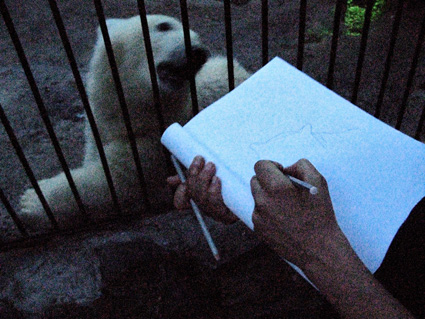 MIreia C. Saladrigues drawing a polar bear in a semi dark Zoo Park. Photo credit: Ulla Taipale
MIreia C. Saladrigues drawing a polar bear in a semi dark Zoo Park. Photo credit: Ulla Taipale
At first we were worried about not finding enough people to take part in the survey. These concerns disappeared once in Novosibirsk. On a normal summer day the Zoo counted more than 10 000 visitors. The news about this special opportunity spread also through the seven biggest TV-news of Siberia that interviewed us and the invitation to participate in the project circulated around through television, radio, city forum in internet and by Mireia´s posters in the Zoo.
On the actual eclipse day, Mireia and ten Russian volunteers delivered and recollected the Zoolar Eclipse postcards for and from one hundred zoo visitors, interested in writing their impressions of the effects of the sudden disappearance of the sun. She herself decided to observe the gibbons. In the moment of eclipse, she says, the role of the one that in the zoo normally is observed – the gibbon – changed and these primates were the ones that observed the humans, totally excited, yelling and shouting as apes in a state of climax.
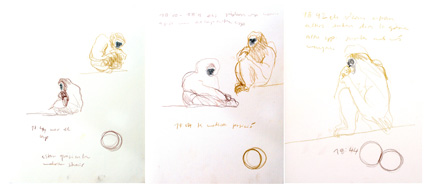 During the totalirity, Mireia C. Saladrigues chose the white-handed gibbons of Zoo as the object of her observation, due to their similarity with the humans. The drawings explain their activities during the eclipse. Image credit, Mireia C. Saladrigues
During the totalirity, Mireia C. Saladrigues chose the white-handed gibbons of Zoo as the object of her observation, due to their similarity with the humans. The drawings explain their activities during the eclipse. Image credit, Mireia C. Saladrigues
The texts by zoo visitors are now being translated from russian to finnish, english and to spanish and the contents seem to be quite touching and subjective. People have interpreted the behavior of animals in very different ways. The writings describe also strange physiological changes in the observers themselves, such as headache, dizziness, extreme feelings of happiness and even sudden hunger. The texts will be available on the website of Capsula Expeditions once they have been completed in english.
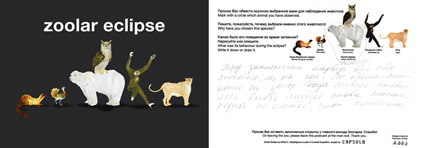 A postcard by Mireia C. Saladrigues and the written observations by a Novosibirsk Zoo visitor. Image credit, Mireia C. Saladrigues
A postcard by Mireia C. Saladrigues and the written observations by a Novosibirsk Zoo visitor. Image credit, Mireia C. Saladrigues
While Mireia´s work took place in semi-artificial surroundings inhabited by wild animals, Agnes moved special Moon Geese to a natural setting to realise her bio-poetic investigation. The Moon Goose Experiment is based on a text by english bishop Francis Godwin and was published first in 1638 in the book called “The Man in the Moone”. The geese of Godwin`s novel fly to the Moon instead of heading to the South in autumn. Would that be something that could happen for some species of migrating birds soon, as an consequence of the search for more suitable habitats than a polluted planet Earth, facing the effects of climatic chaos?
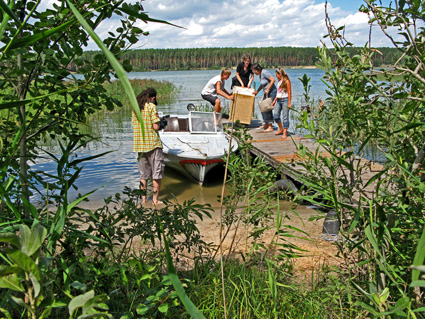 Arrival on the Sacred Scarabeus island, where the Moon Goose Experiment was carried out. Agnes Meyer-Brandis and Alexandra Deribas unload the moon flight equipment. Photo credit, Ulla Taipale
Arrival on the Sacred Scarabeus island, where the Moon Goose Experiment was carried out. Agnes Meyer-Brandis and Alexandra Deribas unload the moon flight equipment. Photo credit, Ulla Taipale
To find the required thirteen suitable Moon Geese and a runway for a moon flight in beautiful natural surroundings was an adventure, and only the determination of Agnes made this possible. Despite the fact that geese are protagonists of her work, also here the local people were playing a very important role in helping to carry out the plan. With the collaboration of Novosibirsk assistants we experienced unforgettable moments in a russian datsa, a typical small farmhouse with all kind of domestic animals, and on a sand island that was chosen to be the experiment scenery. This datsa was situated near to the Academgorodok, the Soviet époque’s ambitious science city project.
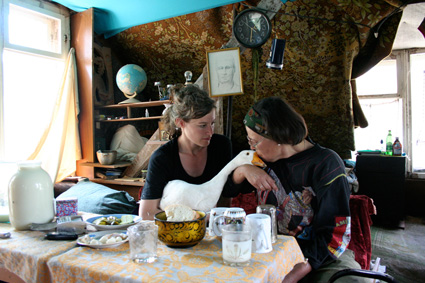 Agnes Meyer Brandis and Alexandra Deribas during geese training in Moon Goose Home, “Datsa” (little farm) of Alexandra and Gennardy Deribas near Akademgorodok, Novosibirsk. Photo credit Agnes Meyer Brandis
Agnes Meyer Brandis and Alexandra Deribas during geese training in Moon Goose Home, “Datsa” (little farm) of Alexandra and Gennardy Deribas near Akademgorodok, Novosibirsk. Photo credit Agnes Meyer Brandis
The actual Experiment was brought to fruition on that small sandy island “Sacred Scarabeus” in Ob River, an hours´ drive away from Novosibirsk centre. The Moon Goose Experiment crew arrived there early in the morning, on the 1st of August, to prepare the flight equipment and do all the necessary preparations. At 17.45 local time, we had the chance to witness a historical takeoff by Ljuba, a young Russian astronaut, and her moon flight in the darkness, provoked by the total solar eclipse. You can find a detailed report of the day on Agnes´web page.
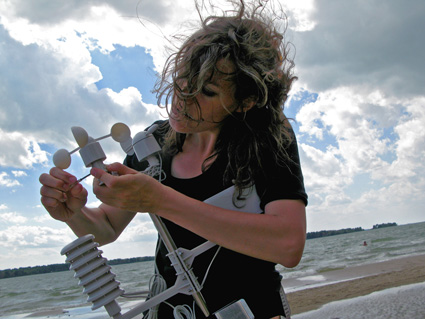 Agnes Meyer-Brandis is fixing pieces of the weather station in the Scarabeus island in SIberia. The sky was cloudy and and the wind was blowing almost 14 m/s just an hour before the total eclipse. Photo credit, Ulla Taipale
Agnes Meyer-Brandis is fixing pieces of the weather station in the Scarabeus island in SIberia. The sky was cloudy and and the wind was blowing almost 14 m/s just an hour before the total eclipse. Photo credit, Ulla Taipale
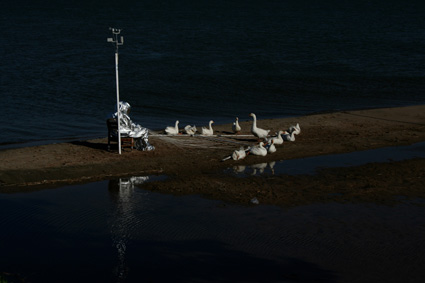 After the first touch, contact of moon and sun at 16.45, the geese stayed calm and Luba, the parachutist got ready for the Moon flight. Image: Agnes Meyer-Brandis
After the first touch, contact of moon and sun at 16.45, the geese stayed calm and Luba, the parachutist got ready for the Moon flight. Image: Agnes Meyer-Brandis
What can artists bring to the vision and experience of natural phenomenon which have already been widely studied by scientists?
A scientist follows his/hers paths of research and an artist his/hers, and both can achieve surprising findings in the same object of investigation. In the end, Curated Expeditions is not trying to gain results that would have scientific importance. The objective is to bring together artists and scientists to work at the intersection of different disciplines, but the results are art works and don’t have to contribute to scientific studies about natural phenomena. What I would like them to contribute is to the recognition of small and big miracles of nature and consciousness about its extraordinariness.
I like the way that Ian McKeever, the english artist, describes the work of scientific and artistic researcher in his text from “Ikijää – Permafrost” (edited by Marketta Seppälä and Yrjö Haila) :
Scientists, like artists, seem to spend a lot of time just looking and thinking around things, engaged in refreshingly simple observation. There are other parallels, too. Both scientists and artists seem to divide their time between doing field-work and going back to base to do the actual donkey work itself. On the surface it looks like both are moving in the same direction, only on different trains, so to speak.
At the moment all us “expeditioners” are “unzipping” the material gathered during the journey- photographs, drawings, videos, writings, and impressions that we lived during this cross-disciplinary expedition. Little by little the final artworks and the ways to present the fruits of the expedition are taking form, the reflections and ideas get processed in our minds. The three proposals were materialized and they are now in progress, the end is not determined.
Talking about visions, I would be very content, if, inspired by these and future proposals, the audience would let their imagination fly a bit further and travel along the migrating birds in the sky to new, surprising destinies, and, instead of purchasing a low cost flight to do shopping in a nearby European country someone would take his bicycle and see what adventures can be lived in the next village. These are some examples of different thinking that the artists could bring to our techno-scientific society where even natural phenomena is tried to be explained and reasoned.
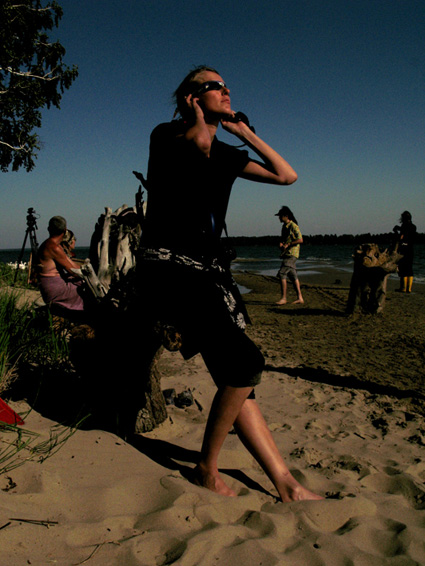 Ulla Taipale in Siberian Scarabeus island, in the strange light during the moment of totality, that lasted 2 minutes 20 seconds, at 17.45 pm. Image Capsula, author unknown
Ulla Taipale in Siberian Scarabeus island, in the strange light during the moment of totality, that lasted 2 minutes 20 seconds, at 17.45 pm. Image Capsula, author unknown
Now that you are back from these adventures, which conclusions do you draw from the experience? What did you learn from the first curated expedition?
It is extremely hard to work with a tiny budget in a country where you don´t know the language and have to depend on many volunteers help. But it is really rewarding when suddenly you discover a bunch of people who are willing and motivated to help you and share the vision that has inspired you to go so far. We can´t thank enough of all the people who helped us in Novosibirsk and during the year to prepare everything. The success of the project was depending on their collaboration. The next expeditions hopefully have bigger budget, but, at the same time I would love to be able to collaborate with local people where ever these projects will happen. Sometimes big resources cause certain distance to the place where you go, the production is taken care of by a professional crew and personal contacts with ordinary people of the locality are lacking. That can be extremely called “cultural colonialism”. I wish to continue Curated Expeditions with the possibility to experience these real meetings with local people.
Despite certain difficulties during the preparation phase of the projects, the artists have shown big talent, imagination and capacity of improvisation to get everything ready for the 1st August when the solar total eclipse happened.
What are Capsula’s upcoming projects?
The Moon Goose Experiment, Zoolar Eclipse and The Journey to the Eclipse will be shown for the first time in Helsinki, Finland, in March 2009, in the Museum of Contemporary Art Kiasma. The show is called “Expedition to the Total Eclipse” and organised as a part of Pixelache09 Festival activities that will consist of an exhibition, (from 6th March until 7th June, 2009), a seminar and some extra activities in the astronomical observatory of URSA. I am invited to stay as a resident in HIAP production residency during February and live in a fortress island Suomenlinna, close to Helsinki centre.
The second Curated Expedition, that will be related to the Baltic Sea, is being maturated at the moment and Capsula is also involved in activities that the Finnish Society of Bioart is organising in Kilpisjärvi Biological Station in Lapland during 2009. Their focus is in arctic biology, climatic and environmental changes and their artistic exploration. The news of Capsula will be published on the website and through the blog.
The next total solar eclipse will occur in India and China in 22nd July, 2009.
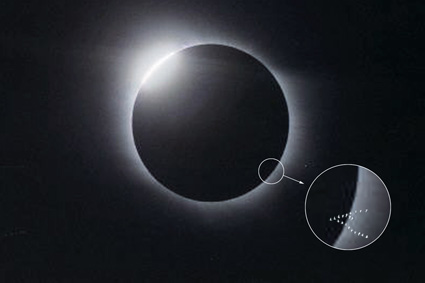 Rare Moon Geese are getting close to the Moon during the total eclipse. Image credit: Agnes Meyer-Brandis
Rare Moon Geese are getting close to the Moon during the total eclipse. Image credit: Agnes Meyer-Brandis
Capsula´s Curated Expedition has received support from:
Zoo of Novosibirsk, FRAME Finnish Fund for Art Exchange, AECID (Agencia Española de Cooperación Internacional para el Desarrollo), VR (Finnish Railways), Venäjän ja Itä-Euroopan Instituutti (The Institute for Russia and Eastern Europe), Finnish Embassy in Moscow, Generalkonsulat der Bundesrepublik Deutschland in Nowosibirsk (General Consulate of the Federal Republic of Germany in Novosibirsk), A MINIMA magazine, Agrupación Astronómica de Sabadell (Spain), AirBerlin, Helsinki University – Kilpisjärvi Biological Station (Finland), University of Art & Design, Pori Department (Finland) , ARPI – professional photostore (Barcelona), NCCA Ekaterinburg (National Centre for Contemporanean Art, Russia), Colección Sabater Pi (Barcelona), Korkeasaari Zoo (Helsinki), SAS Royal Hotel (Helsinki), Sodexo Oy / Hostel Satakuntatalo (Helsinki), Antares Ltd (Barcelona), Fire Department Cologne, Tesimax (Germany), HMKV Dortmund
The exhibition “Expedition to the total eclipse” has received support from:
Pixelache09, Kiasma, HIAP (Helsinki International Artist-in-residence Programme), AVEK (The Promotion Centre for Audiovisual Culture in Finland), Taiteen Keskustoimikunta (Finnish Art Council)
Special thanks for Anneli Ojala from The Institute for Russia and Eastern Europe for translating the Zoolar Eclipse postcards in Finnish!
Thanks Ulla!
